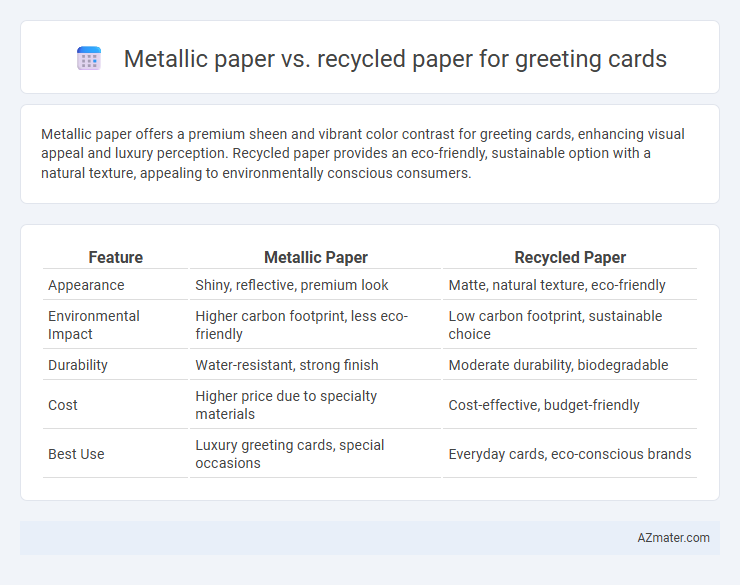Metallic paper offers a premium sheen and vibrant color contrast for greeting cards, enhancing visual appeal and luxury perception. Recycled paper provides an eco-friendly, sustainable option with a natural texture, appealing to environmentally conscious consumers.
Table of Comparison
| Feature | Metallic Paper | Recycled Paper |
|---|---|---|
| Appearance | Shiny, reflective, premium look | Matte, natural texture, eco-friendly |
| Environmental Impact | Higher carbon footprint, less eco-friendly | Low carbon footprint, sustainable choice |
| Durability | Water-resistant, strong finish | Moderate durability, biodegradable |
| Cost | Higher price due to specialty materials | Cost-effective, budget-friendly |
| Best Use | Luxury greeting cards, special occasions | Everyday cards, eco-conscious brands |
Introduction to Greeting Card Paper Choices
Greeting card paper choices significantly impact the visual appeal and environmental footprint of the final product, with metallic paper offering a glossy, reflective finish that enhances color vibrancy and luxury feel. Recycled paper emphasizes sustainability, often featuring a textured surface and natural tones that appeal to eco-conscious consumers while reducing waste and resource consumption. Selecting between metallic and recycled paper depends on balancing aesthetics, tactile experience, and environmental responsibility in greeting card production.
What is Metallic Paper?
Metallic paper is a specialty paper coated with a thin layer of metallic pigments, giving it a shiny, reflective surface ideal for premium greeting cards. This paper type enhances visual appeal with its lustrous finish, making colors appear more vibrant and designs more eye-catching. Compared to recycled paper, metallic paper prioritizes aesthetics and luxury over environmental benefits, often used for special occasions where presentation is key.
What is Recycled Paper?
Recycled paper is produced from recovered fiber materials such as post-consumer waste and industrial scrap, minimizing environmental impact by reducing deforestation and energy consumption. It retains the natural texture and earthy tones, offering an eco-friendly option for greeting cards with a more muted, matte finish compared to the glossy, reflective surface of metallic paper. Choosing recycled paper supports sustainability goals and appeals to environmentally conscious consumers seeking biodegradable and renewable materials.
Environmental Impact: Metallic vs Recycled Paper
Metallic paper production consumes more energy and involves plastic coatings, contributing to lower biodegradability and increased environmental pollution. Recycled paper for greeting cards significantly reduces deforestation, waste, and carbon emissions due to its use of post-consumer materials and less intensive manufacturing processes. Choosing recycled paper supports circular economy principles and minimizes landfill waste compared to the ecological drawbacks of metallic paper.
Print Quality and Aesthetics Comparison
Metallic paper offers a high-gloss, reflective finish that enhances colors and details, providing a luxurious and vibrant look ideal for premium greeting cards. Recycled paper features a more matte, natural texture with muted tones, appealing to eco-conscious consumers but often lacking the sharpness and richness found in metallic prints. Print quality on metallic paper excels in saturation and sharpness, while recycled paper prioritizes sustainability with modest aesthetic appeal.
Cost Differences: Metallic vs Recycled Paper
Metallic paper typically costs 20-40% more than recycled paper due to its specialty coating and reflective finish, which require more complex manufacturing processes. Recycled paper is generally more economical, benefiting from lower raw material expenses and environmental incentives that reduce overall production costs. Choosing metallic paper increases the greeting card's production budget, while recycled paper supports affordability and sustainability efforts.
Durability and Longevity Factors
Metallic paper offers superior durability for greeting cards due to its sturdy coating and resistance to moisture and wear, making it ideal for preserving vibrant designs over time. In contrast, recycled paper typically has a rougher texture and lower weight, which may result in quicker degradation and less protection from environmental factors. Choosing metallic paper enhances longevity and maintains aesthetic appeal, especially for special occasion cards intended to be kept as keepsakes.
Customization and Design Flexibility
Metallic paper offers vibrant, reflective surfaces that enhance intricate designs and enable high-quality color personalization ideal for premium greeting cards. Recycled paper provides a matte, textured finish with limited color vibrancy but supports eco-friendly customization through natural, earthy tones and unique fibers. Design flexibility on metallic paper allows for sharp detail and foil stamping effects, while recycled paper encourages creative use of typography and minimalist design for sustainable appeal.
Consumer Preferences and Trends
Consumers increasingly favor metallic paper for greeting cards due to its luxurious finish and ability to enhance colors and designs, making cards stand out for special occasions. Recycled paper appeals to environmentally conscious buyers seeking sustainable options that reduce ecological impact without sacrificing quality. Market trends indicate a growing demand for eco-friendly products, yet many consumers continue to prioritize the visual and tactile appeal of metallic paper for premium greeting cards.
Choosing the Best Paper for Greeting Cards
Metallic paper offers a vibrant, shiny finish that enhances the visual appeal of greeting cards with its reflective surface and rich colors, making it ideal for festive or luxury occasions. Recycled paper provides an eco-friendly option, emphasizing sustainability without compromising on texture or print quality, appealing to environmentally conscious consumers. Choosing the best paper depends on the desired aesthetic and environmental values, balancing the premium look of metallic paper with the green benefits of recycled materials.

Infographic: Metallic paper vs Recycled paper for Greeting card
 azmater.com
azmater.com